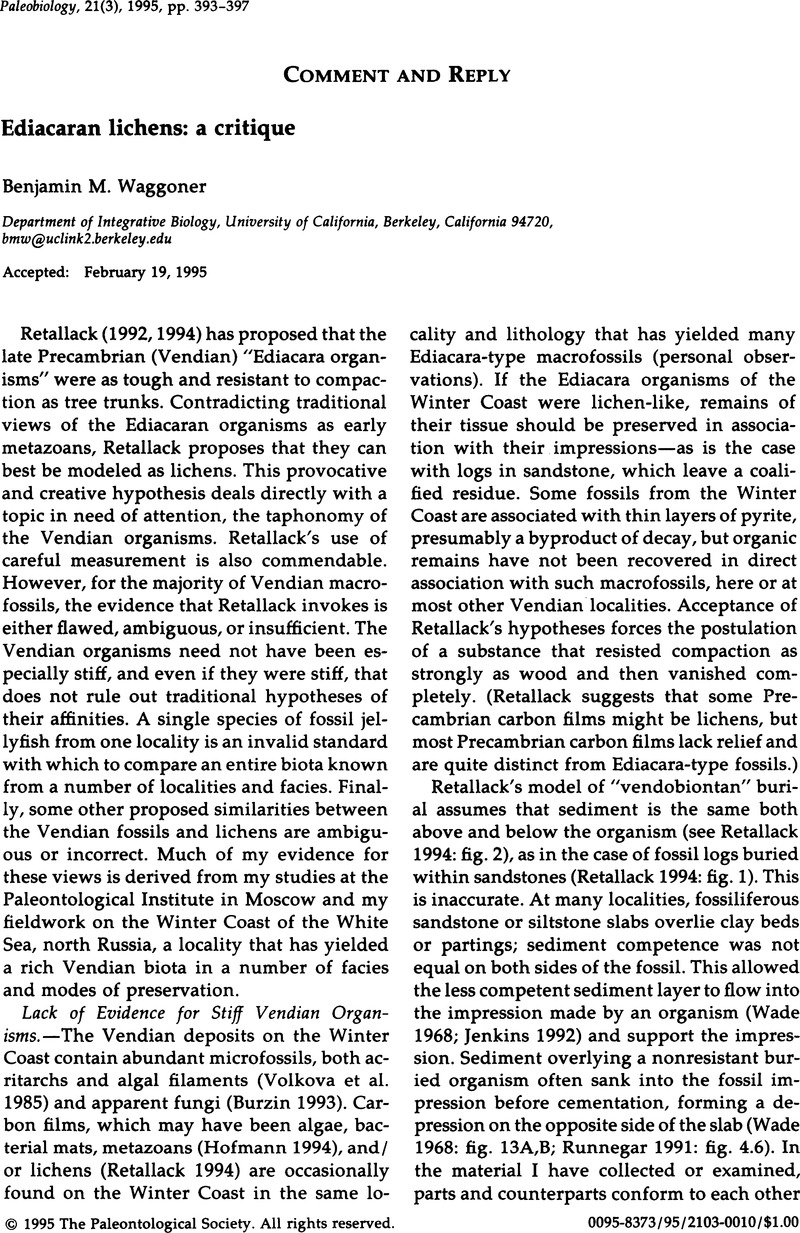Crossref Citations
This article has been cited by the following publications. This list is generated based on data provided by Crossref.
Fedonkin, Mikhail A.
1998.
Metameric features in the Vendian metazoans.
Italian Journal of Zoology,
Vol. 65,
Issue. 1,
p.
11.
Hofmann, H.J.
1998.
Geology of the Precambrian Superior and Grenville Provinces and Precambrian Fossils in North America.
p.
271.
Lipps, Jere H.
and
Culver, Stephen J.
2002.
The Trophic Role of Marine Microorganisms Through Time.
The Paleontological Society Papers,
Vol. 8,
Issue. ,
p.
69.
Lipps, Jere H.
and
Valentine, James W.
2004.
Late Neoproterozoic Metazoa: Weird, Wonderful and Ghostly.
The Paleontological Society Papers,
Vol. 10,
Issue. ,
p.
51.
Taylor, T.N.
and
Krings, M.
2005.
Encyclopedia of Geology.
p.
436.
Schulze‐Makuch, Dirk
Irwin, Louis N.
Lipps, Jere H.
LeMone, David
Dohm, James M.
and
Fairén, Alberto G.
2005.
Scenarios for the evolution of life on Mars.
Journal of Geophysical Research: Planets,
Vol. 110,
Issue. E12,
Shu, D.-G.
Morris, S. Conway
Han, J.
Li, Y.
Zhang, X.-L.
Hua, H.
Zhang, Z.-F.
Liu, J.-N.
Guo, J.-F.
Yao, Y.
and
Yasui, K.
2006.
Lower Cambrian Vendobionts from China and Early Diploblast Evolution.
Science,
Vol. 312,
Issue. 5774,
p.
731.
Callow, Richard H.T.
and
Brasier, Martin D.
2009.
Remarkable preservation of microbial mats in Neoproterozoic siliciclastic settings: Implications for Ediacaran taphonomic models.
Earth-Science Reviews,
Vol. 96,
Issue. 3,
p.
207.
Brasier, Martin D.
and
Antcliffe, Jonathan B.
2009.
Evolutionary relationships within the Avalonian Ediacara biota: new insights from laser analysis.
Journal of the Geological Society,
Vol. 166,
Issue. 2,
p.
363.
Brasier, Martin D.
Antcliffe, Jonathan B.
and
Callow, Richard H. T.
2010.
Taphonomy.
Vol. 32,
Issue. ,
p.
519.
Forsey, George F.
2013.
Fossil evidence for the escalation and origin of marine mutualisms.
Journal of Natural History,
Vol. 47,
Issue. 25-28,
p.
1833.
Antcliffe, Jonathan B.
and
Hancy, Anthony
2013.
Critical questions about early character acquisition—Comment on Retallack : “Some Ediacaran fossils lived on land”.
Evolution & Development,
Vol. 15,
Issue. 4,
p.
225.
MacGabhann, Breandán Anraoi
2014.
There is no such thing as the ‘Ediacara Biota’.
Geoscience Frontiers,
Vol. 5,
Issue. 1,
p.
53.
Duda, Jan-Peter
Blumenberg, Martin
Thiel, Volker
Simon, Klaus
Zhu, Maoyan
and
Reitner, Joachim
2014.
Geobiology of a palaeoecosystem with Ediacara-type fossils: The Shibantan Member (Dengying Formation, South China).
Precambrian Research,
Vol. 255,
Issue. ,
p.
48.
Droser, Mary L.
Gehling, James G.
Dzaugis, Mary E.
Kennedy, Martin J.
Rice, Dennis
and
Allen, Michael F.
2014.
A new Ediacaran fossil with a novel sediment displacive life habit.
Journal of Paleontology,
Vol. 88,
Issue. 1,
p.
145.
Taylor, Thomas N.
Krings, Michael
and
Taylor, Edith L.
2015.
Systematics and Evolution.
p.
259.
Hawksworth, David L.
2015.
Recent Advances in Lichenology.
p.
1.
Lipnicki, Ludwik I.
2015.
The role of symbiosis in the transition of some eukaryotes from aquatic to terrestrial environments.
Symbiosis,
Vol. 65,
Issue. 2,
p.
39.
2015.
Fossil Fungi.
p.
297.
Hartl, C.
Schmidt, A. R.
Heinrichs, J.
Seyfullah, L. J.
Schäfer, N.
Gröhn, C.
Rikkinen, J.
and
Kaasalainen, U.
2015.
Lichen preservation in amber: morphology, ultrastructure, chemofossils, and taphonomic alteration.
Fossil Record,
Vol. 18,
Issue. 2,
p.
127.



